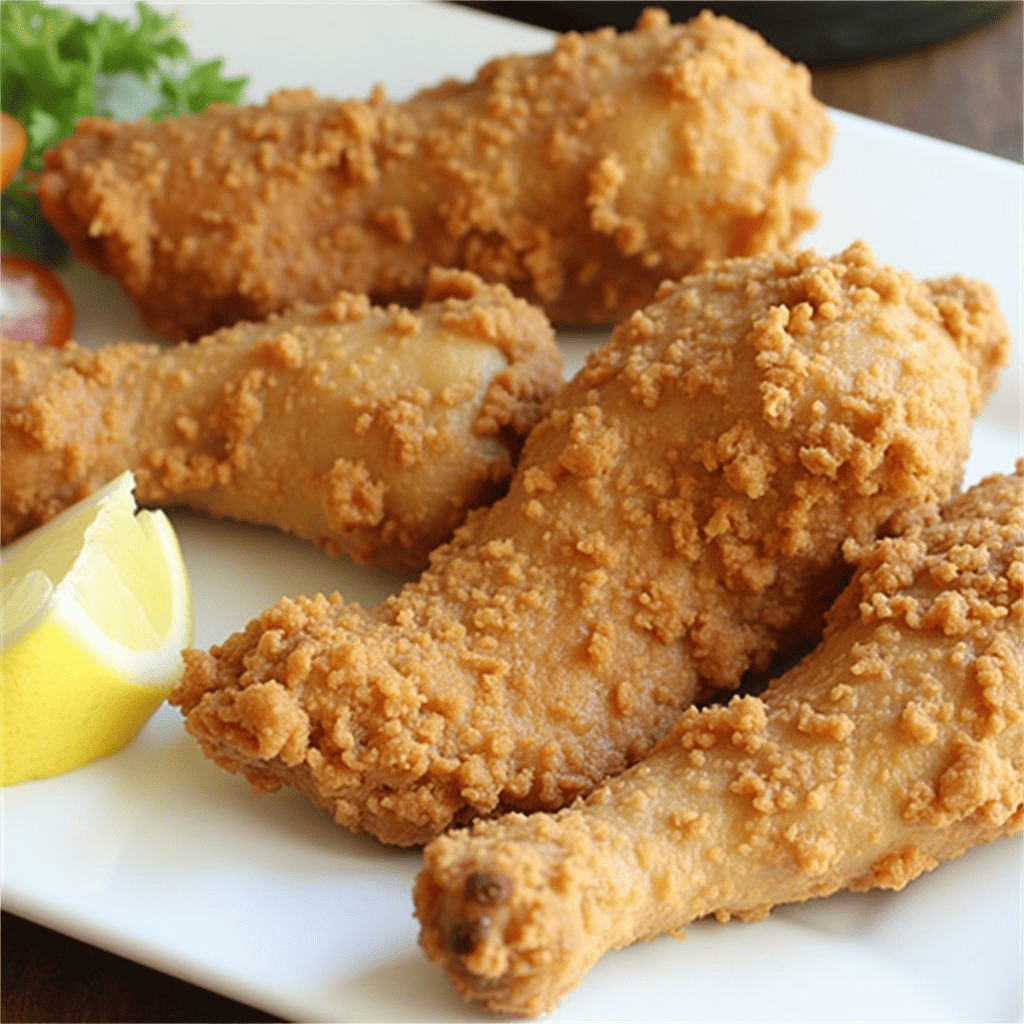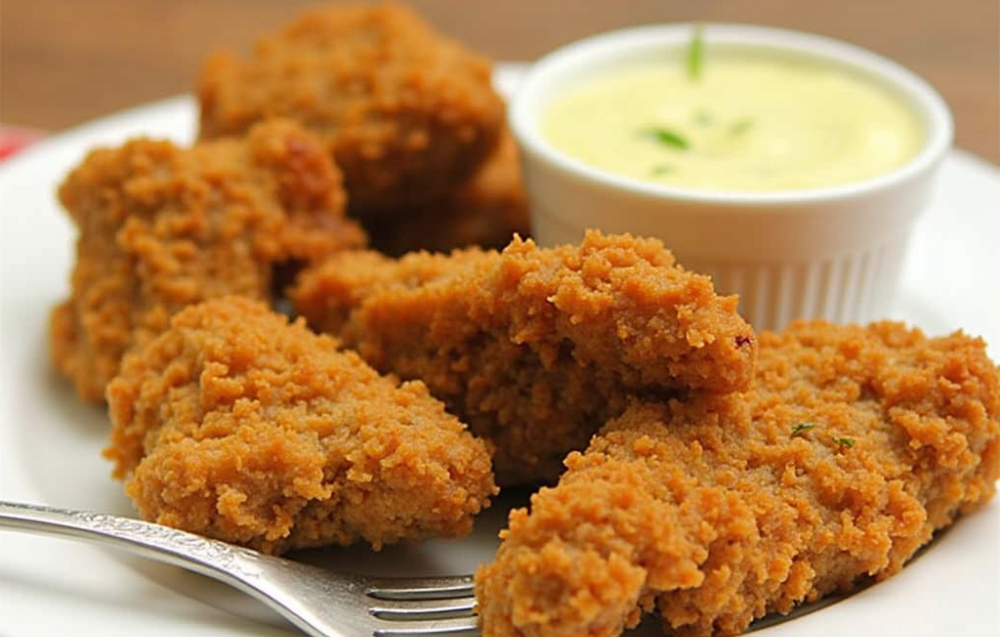Is there anything more satisfying than biting into a piece of perfectly crispy fried chicken? That golden, crunchy coating that gives way to juicy, flavorful meat—it’s pure heaven. But let’s be honest, getting that perfect crunch at home isn’t always easy. Sometimes, the coating falls off, the chicken turns out soggy, or the inside is undercooked.
If you’ve ever wondered how to make the best crispy fried chicken, you’re in the right place. In this ultimate guide, we’ll break down everything you need to know—from choosing the right ingredients to troubleshooting common mistakes. By the end, you’ll be frying up chicken so good, your friends and family will beg you to make it every week! if you want a delicious baked alternative, check out this Chicken Rice Casserole—an easy, one-pan dish that’s perfect for repurposing fried chicken leftovers.
Introduction to Crispy Fried Chicken
Why Fried Chicken is a Global Favorite
Fried chicken isn’t just food—it’s a worldwide obsession. From Southern-style buttermilk fried chicken in the U.S. to Korean-style double-fried wings, almost every culture has its own version. And for good reason! The contrast between a crunchy, flavorful crust and juicy, tender meat is irresistible.
Whether you enjoy it spicy, sweet, or extra crispy, fried chicken is one of those comfort foods that never goes out of style.

What Makes Fried Chicken Crispy?
The secret to crispy fried chicken boils down to a few key factors:
- Proper Breading Technique – A well-layered coating locks in crunch.
- The Right Oil Temperature – Too hot? It burns. Too cool? It turns soggy.
- Double Coating – More layers = more crunch!
- Resting After Frying – This prevents steam from softening the crust.
Let’s break these down so you can master the art of crispy fried chicken.
If you’re looking for a healthier fried chicken alternative, check out this Air Fryer Honey Butter Garlic Chicken Tenders. Air frying cuts down on oil while still delivering a delicious crispy texture.
The Essential Ingredients for Crispy Fried Chicken
Choosing the Right Chicken: Fresh vs. Frozen
When it comes to frying, fresh chicken is always the best choice. Frozen chicken retains extra moisture, which can lead to a soggy crust. But if frozen is all you have, make sure to thaw it completely and pat it dry with paper towels before using.
For the juiciest results, go for bone-in, skin-on chicken. The skin adds extra crunch, and the bone helps retain moisture, preventing dry meat.
The Best Flour and Coating Mix for Extra Crunch
Not all flour is created equal! A mix of all-purpose flour and cornstarch (or potato starch) gives you that light, crispy texture. Here’s a simple ratio:
✅ 2 cups all-purpose flour
✅ ½ cup cornstarch
Cornstarch helps create that signature airy crispiness found in restaurant-quality fried chicken. If you want an even crunchier texture, swap out some of the flour for rice flour!
Secret Ingredients for the Perfect Flavor
Want that deep, mouthwatering flavor? Marination is key. Here are a few secret ingredients that take fried chicken to the next level:
- Buttermilk – Tenderizes the meat and adds a slight tangy flavor.
- Hot Sauce – Infuses spice into the chicken itself.
- Dijon Mustard – Helps the coating stick and adds a subtle kick.
Let your chicken marinate for at least 4 hours (or overnight for even better results).
Choosing the Right Seasonings and Spices
A great spice mix makes or breaks your fried chicken. Here’s a tried-and-true blend:
🔥 1 tbsp salt
🔥 1 tbsp black pepper
🔥 1 tbsp paprika
🔥 1 tsp garlic powder
🔥 1 tsp onion powder
🔥 ½ tsp cayenne pepper (optional for spice)
Mix these into both your flour coating and your buttermilk marinade for a flavor explosion!
“The secret to incredible fried chicken isn’t just the crunch—it’s the layers of flavor that make every bite unforgettable.”
Step-by-Step Guide to Making Crispy Fried Chicken
Preparing the Chicken: Cleaning and Marinating
Before anything else, you need to prep your chicken properly:
- Trim excess fat – Too much fat can make the crust greasy.
- Pat it dry – Moisture ruins crispiness. Always dry your chicken before marinating.
- Marinate in buttermilk – At least 4 hours, but overnight is best.
This step ensures juicy, flavorful meat every time.
The Double-Coating Technique for Extra Crispiness
A single dip in flour won’t cut it if you want that restaurant-level crunch. Double coating is the way to go:
- Dip in seasoned flour – Shake off excess.
- Dip in buttermilk again – This creates a sticky layer.
- Dip in flour one more time – For that extra thick, crispy crust.
Pro Tip: Let the coated chicken rest for 10 minutes before frying. This helps the coating stick better and prevents it from falling off in the oil.
For an in-depth breakdown of coating techniques, check out Serious Eats’ Crispy Fried Chicken Guide.
Choosing the Best Oil for Deep Frying
The right oil makes a HUGE difference. Avoid olive oil (burns too fast) and go for high-smoke-point oils like:
- Peanut oil – Best for flavor and crispiness.
- Canola oil – Neutral flavor and budget-friendly.
- Vegetable oil – A great all-purpose option.
Fill your frying pot at least 2 inches deep for best results.
The Right Temperature for Perfectly Cooked Chicken
Here’s where many people mess up—temperature control.
- Too low (below 325°F) – The chicken absorbs too much oil, becoming greasy.
- Too high (above 375°F) – The outside burns before the inside cooks.
- Perfect frying temp: 350°F – This ensures a golden, crispy crust and juicy interior.
Use a thermometer to check the temperature before adding chicken and adjust as needed.
How Long to Fry Chicken for Maximum Crispiness
Cooking times vary based on size, but here’s a good rule of thumb:
🍗 Drumsticks & Thighs – 12 to 15 minutes
🍗 Wings – 8 to 10 minutes
🍗 Boneless pieces – 6 to 8 minutes
The internal temp should hit 165°F for safe eating. Use a meat thermometer to check.
“Perfect fried chicken isn’t just about frying—it’s about patience, technique, and knowing when to stop!”
Common Problems and Solutions When Frying Chicken
Even if you follow every step, fried chicken can sometimes turn out less than perfect. Maybe it’s too greasy, the coating falls off, or the inside is raw. Don’t worry—these are all fixable! Here are some common problems and how to solve them.
Why is My Fried Chicken Not Crispy?
Nothing is worse than soggy fried chicken when you were expecting crunch. Here’s why it happens:
- Oil temperature is too low – Always fry at 350°F. If the oil is too cool, the chicken absorbs too much oil, making it greasy.
- Too much flour on the chicken – Excess flour creates a powdery coating rather than a crisp crust. Shake off any extra flour before frying.
- Overcrowding the pan – If you add too many pieces at once, the oil temperature drops, leading to soggy chicken. Fry in small batches.
💡 Solution: Use a thermometer to monitor your oil, coat your chicken lightly, and fry in batches.
How to Prevent Soggy Fried Chicken
Even if your chicken is crispy at first, it can turn soggy if not handled properly after frying. Here’s what to do:
❌ Don’t drain on paper towels – This traps steam, softening the crust.
✅ Use a wire rack – Place fried chicken on a cooling rack over a baking sheet. This lets air circulate and keeps it crispy.
✅ Keep fried chicken warm in the oven – If cooking multiple batches, place cooked pieces in a 200°F oven on a rack until ready to serve.
“Crispy fried chicken is like a first impression—you only get one shot to get it right!”
How to Avoid Overcooking or Undercooking Chicken
Ever cut into your fried chicken and found it raw inside? Or maybe it’s dry and overcooked? Here’s how to avoid both:
🔥 For even cooking:
- Let chicken sit at room temperature for 30 minutes before frying. Cold chicken lowers oil temp, making the outside cook faster than the inside.
- Use a meat thermometer—the thickest part of the chicken should reach 165°F.
🔥 For juicy chicken:
- Marinate in buttermilk – This keeps the meat tender.
- Don’t overcook! Remove chicken from oil once it reaches the right temperature.
How to Keep Fried Chicken Crispy for Hours
Want your fried chicken to stay crispy for a long time? Here’s how:
✅ Use the oven – Set your oven to 200°F, place chicken on a wire rack, and keep it warm without overcooking.
✅ Avoid covering with foil – This traps moisture and makes the crust soggy.
✅ Reheat the right way – We’ll cover this in the next section!
“Fried chicken should be crispy enough to hear the crunch from across the room!”
How to Store and Reheat Fried Chicken Without Losing Crispiness
Got leftovers? Fried chicken can still taste amazing the next day if stored and reheated properly.
Best Storage Tips for Leftover Fried Chicken
To keep fried chicken fresh:
- Let it cool completely – Storing warm chicken creates steam, ruining the crispiness.
- Use an airtight container – Store in a container with a paper towel at the bottom to absorb excess oil.
- Refrigerate within 2 hours – Don’t leave fried chicken sitting out too long.
✅ Fridge: Good for up to 4 days
✅ Freezer: Good for up to 3 months (wrap tightly in foil and store in a ziplock bag)
The Right Way to Reheat Fried Chicken
Reheated fried chicken should taste just as good as fresh. Avoid the microwave—it makes the crust soggy. Instead, try these methods:
🔥 Best Method (Oven & Air Fryer)
- Preheat oven to 375°F (or air fryer to 350°F).
- Place chicken on a wire rack over a baking sheet.
- Bake for 15-20 minutes (or 7-10 min in an air fryer) until crispy and hot inside.
This method restores the crunch while keeping the meat juicy.
“Great fried chicken deserves a great comeback. Reheat it right, and it’s just as good the second time!”
Best Side Dishes to Serve with Crispy Fried Chicken
Fried chicken is the star, but the right side dishes elevate the meal. Whether you want classic Southern comfort food or healthier options, we’ve got you covered.
Classic Southern Sides
Want the full Southern experience? These sides are must-haves:
- Buttermilk Biscuits – Flaky, buttery perfection.
- Mac & Cheese – Creamy, cheesy, and indulgent.
- Coleslaw – Crunchy and tangy, balancing the richness of fried chicken.
- Mashed Potatoes & Gravy – Because why not add more comfort?
- Cornbread – Sweet and moist, pairs perfectly with crispy chicken.
Healthy Side Dish Options
Want a lighter meal? Try these fresh, healthier sides:
🌿 Grilled Vegetables – Bell peppers, zucchini, and asparagus add a smoky touch.
🥗 Kale Salad – Tossed with lemon vinaigrette for a refreshing contrast.
🍠 Sweet Potato Fries – A slightly sweet, healthier alternative to regular fries.
🥒 Pickles or Pickled Veggies – The acidity cuts through the fried goodness.
“Great fried chicken deserves sides that make the whole meal unforgettable.”
Conclusion: Mastering the Art of Crispy Fried Chicken
Final Tips for the Best Homemade Fried Chicken
Let’s wrap up everything we’ve learned:
✅ Marinate in buttermilk for tenderness.
✅ Double coat with seasoned flour & cornstarch for maximum crunch.
✅ Fry at 350°F to avoid soggy or burnt chicken.
✅ Drain on a wire rack (not paper towels) to keep it crispy.
✅ Reheat in the oven (not microwave) to restore crunch.
Follow these steps, and you’ll never have to settle for mediocre fried chicken again!
Experimenting with New Flavors and Styles
Now that you’ve mastered the basics, why not get creative? Try these variations:
🔥 Spicy Nashville Hot Chicken – Toss in a cayenne-infused butter sauce.
🍯 Honey Butter Fried Chicken – Drizzle with honey butter for a sweet-savory combo.
🌿 Garlic Parmesan Fried Chicken – Coat in garlic butter and parmesan cheese.
🍛 Korean Fried Chicken – Glaze with spicy gochujang sauce.
The possibilities are endless—so go ahead and experiment!
“Fried chicken isn’t just food—it’s an art. Master it, and you’ll always have a meal that makes people smile.”
Final Thoughts
Making crispy fried chicken at home isn’t hard—it just takes the right technique and a little patience. Whether you like it classic, spicy, or extra crunchy, following these steps will ensure perfect fried chicken every time.
Now, go grab some chicken, heat up the oil, and start frying! 🍗🔥

